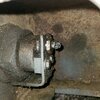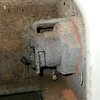Try removing the two small bolts, the keeper plate and the block. That will allow you to remove the "double nut" (arrowed) as an assembly which likely has a check valve inside it. Try installing the zerk into the assembly with it off the machine and see if you can pump grease through it. If it won't take grease then the check valve would appear to be stuck. You might manage to free it with some form of penetrating oil or paraffin.
By "keeper plate", do you mean the L shaped bracket that's there to stop the bleeder from coming off if the nut is over loosened?
From what I've been reading about these, there's some 15,000 PSI of pressure behind these nuts. From what I can tell from reading the manual, it is only the outer (large) hex nut that is supposed to be loosened (maximum of one turn) to let the grease ooze out.
I assume that this procedure is done AFTER the pressure is released from this cylinder. Then the bracket, nut and grease fitting come off. Do I understand that correctly? Is the check valve in the grease fitting itself? I looked at a video of how a grease fitting works and it showed a ball bearing with a spring behind it. The spring keeps the bearing up against the opening in the tip of the fitting, sealing it shut. Effectively, a check valve.
It looks like the outer nut is the one the manual refers to, and is to be loosened no more than one turn, to relieve the grease from the cylinder. The L bracket and both nuts come off to remove the whole assembly for inspection? Can't the Zerk itself be removed without taking it all apart first? Or is that a safety issue?
This cylinder operates at extremely high pressures and I want to be sure I'm doing this safely. People apparently have been seriously injured or even killed because of removing parts that were still under pressure.
The important question (for safety) is how to be certain these nuts are not under pressure before removal.





